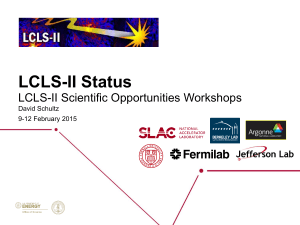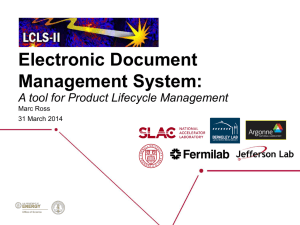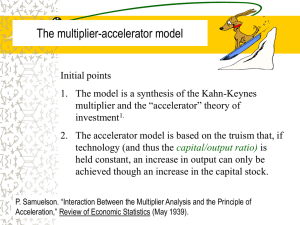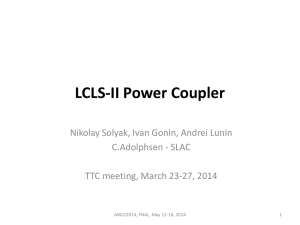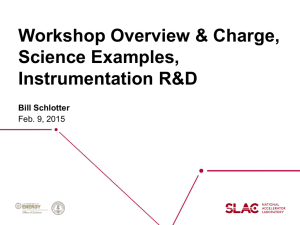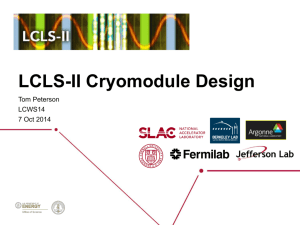Harms_20140409LCLSmeeting
advertisement
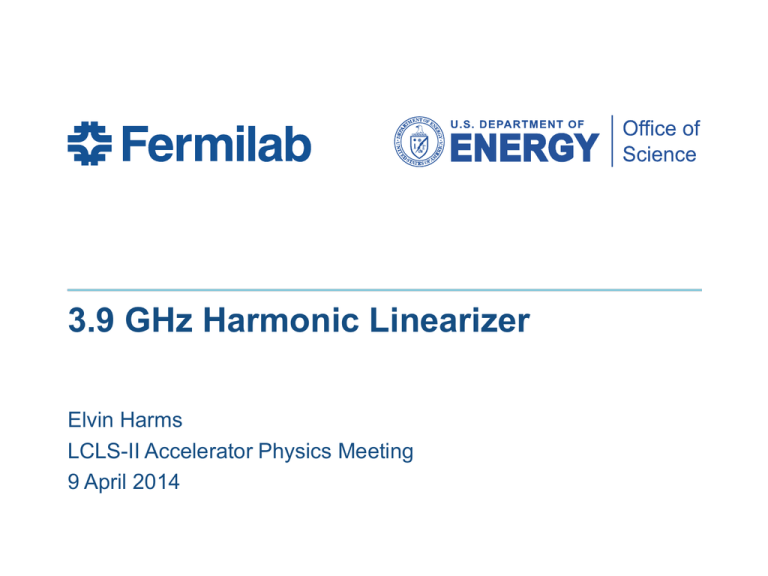
3.9 GHz Harmonic Linearizer Elvin Harms LCLS-II Accelerator Physics Meeting 9 April 2014 Introduction • • • • • ACC39 at FLASH Proposal for LCLS-II LH Parameters Assumptions Summary 2 Harms, LCLS-II Accelerator Physics 9 Apr 2014 The Linearizer module - What is it, What does it do? • The 3.9 GHz module, ACC39, is installed in the DESY FLASH injector just after the 1.3GHz ACC1 (first) cryo module. • It is used in conjunction with ACC1 in order linearize the bunch energy vs. time over the bunch length. • This in turn makes “bunch compression” to very short bunches with high peak currents more efficient, a more controlled longer bunch charge distribution. 3 3 Harms, LCLS-II Accelerator Physics 9 Apr 2014 Bunch Compression with 3.9 GHz Module After acceleration w/o After compression w/o Short bunch Flat bunch ~250 fs From M Dohlus et al With 3rd harmonic 4 4 From P Piot Harms, LCLS-II Accelerator Physics 9 Apr 2014 Test Results • Entire cryomodule was first tested at DESY in their CryoModule Test Bench (CMTB) prior to installation in FLASH – Successful assembly – Successful transatlantic shipment – Some rework at DESY • Longitudinal realignment • Instrumentation terminations 5 5 Harms, LCLS-II Accelerator Physics 9 Apr 2014 ACC39 Performance • Set up for lasing has gone from expert tune up (shifts) to nearly immediate after turn-on 6 6 Harms, LCLS-II Accelerator Physics 9 Apr 2014 ACC39 Performance • • ACC39 routinely operates at 18.9 to 19.7 MV/m Capable of operation at 22 MV/m – Limitation set by thermal interlocks – concern about compromising HOM’s on Cavities 3 & 5 (trimmed 2-post style) • Amplitude stability ≤ 2x10-5 pulse-to-pulse • Phase stability ≤ 0.003° pulse-to-pulse 7 7 Harms, LCLS-II Accelerator Physics 9 Apr 2014 Experiences & Lessons Learned (and applied) • New infrastructure had to be built – Commissioning in parallel with qualifying components • • • • • • HOM redesign – – – • 8 Prototyping and testing is vital before placing order Engineering Notes & Operational Readiness Clearance Transatlantic Transport of a complete cryomodule Welding certification – • Not simply a scaled version Modeling and prototyping important Robust design is the end result HOM coupler antennae – • • • Vertical test stand Horizontal Test Stand Coupler Conditioning Clean rooms … Especially Helium vessels ‘New’ technologies explored and applied Harms, LCLS-II Accelerator Physics 9 Apr 2014 Looking Ahead – CW Operation • Heat Load/Cryogenic piping – Limit total cryomodule heat load to <250 watts – Dynamic Heat Load needs to be revisited • Estimated heat load ~15 watts/cavity @ 15 MV/m • Input coupler power capability/cooling – Current design should be good to ~2kW cw, but needs to be re-analyzed • Studies are possible using coupler stand at A0 with a cw amplifier – Is a variable coupler necessary rather than current ‘fixed’ design 9 Harms, LCLS-II Accelerator Physics 9 Apr 2014 Looking Ahead – CW Operation (2) • HOM coupler and feedthrough capability – Current (single-post) ‘Formteil’ design • multi-pacting lower bound ~25 MV/m – Feedthrough – adequate cooling? – Simulation needed to look at modes (THz?) present in the ends • Absorbing material needed in beam pipe? • Preliminary simulations begun • Microphonics/Fast tuning – Current tuner is slow (blade) tuner only – Cavities are already fairly stiff – resistant to microphonics/LFD – Consider addition of fast/piezo’s or passive microphonics compensation 10 Harms, LCLS-II Accelerator Physics 9 Apr 2014 Looking Ahead – CW Operation (3) • Cavity Global thermal limit is estimated to be of order 25 MV/m • Alignment – Offset = HOM power considerations – Tilt = transverse emittance implications • Other issues to consider – Beam diagnostics, especially internal to module – Quads, dipoles – Cryogenic and vacuum interconnectability to adjacent components – Standalone vs. Integrated module 11 Harms, LCLS-II Accelerator Physics 9 Apr 2014 LCLS-II Layout P. Emma, L. Wang, C. Papadopoulos M. Ross 12 E. Harms Harms, LCLS-II Accelerator 9 Apr2014 2014 APT Seminar 14Physics January Proposed Parameter Set 13 E. Harms Harms, LCLS-II Accelerator 9 Apr2014 2014 APT Seminar 14Physics January 3.9 GHz Section Assumptions - 1 • Cryomodule – – – – – – – 8 cavities per Cryomodule with 2 Cryomodules Total heat load ~200 W / cryomodule No magnet, corrector, or BPM’s in 3.9GHz CM’s Magnets/Quad/BPM will be downstream in warm section Cavities spaced for Q0 > 2e9 Beam pipe tapering from 1.3 GHz CM to 3.9 GHz CM Length of interconnection (distance between CM’s) is free • no requirements in term of wavelength. – Larger diameter 2-phase pipe/nozzle akin to 1.3 GHz • will provide additional cooling than existing design – Cryo interface will be CM2/3 upstream and 'standard' feedbox immediately downstream – Design of cryomodule will strive to bring all signal cables out on the aisle side – Cryomodule will be cooled with the proposed 2nd cryoplant capable of ~1kW at 2K along with the other upstream (non-main Linac) CM’s – Cavity-to cavity distance is short (as in FLASH) – HOM (beam pipe) absorber likely placed between two 3.9 GHz CM’s 14 E. Harms Harms, LCLS-II Accelerator 9 Apr2014 2014 APT Seminar 14Physics January 3.9 GHz Section Assumptions - 2 • Cavities – Capable of 14.5 MV/m cw – Power dissipation ~17 W / cavity, maximum HOM power ~13 W / CM or 1.6 W / cavity • (>50% will dissipated at 70K or RT) – Blade tuner design with 3 piezos incorporated. – HOM coupler signals may be used for beam offset measurements – Consider modest Q0 improvement development program (N2 doping), but low priority and is not project critical • 1- and 9-cell cavities are available for processing & testing 15 E. Harms Harms, LCLS-II Accelerator 9 Apr2014 2014 APT Seminar 14Physics January 3.9 GHz Section Assumptions - 3 • Couplers – Cavity orientation for placement downstream and every second rotated by 180° – Dig tunnel wall if necessary to make room for coupler clearance • “not out of the question” – Waveguide from back side of CM will be pre-assembled and extend to top of CM for connection – Two options for klystron to CM feed: Waveguide or coax • WG option is preferable • coax is lossier, possible center conductor heating – Coupler will require modifications for CW regime – Fixed coupling (Q~1.e7) looks OK. 16 E. Harms Harms, LCLS-II Accelerator 9 Apr2014 2014 APT Seminar 14Physics January Coupler Orientation Options Fermilab Cryomodule Layout: Arun Saini, N. Solyak XFEL Cryomodule Layout: Start here FLASH Cryomodule Layout: 17 E. Harms Harms, LCLS-II Accelerator 9 Apr2014 2014 APT Seminar 14Physics January Goal 1.30 GHz Coupler Orientation Summary • Beam optics through harmonic section is studied. • • • • • Fermilab configuration XFEL Configuration ILC type cryomodule Start here Goal 1.30 GHz Coupler RF kick results in significant emittance growth. Local compensation of coupler kick is possible and emittance dilution can be minimized using different orientations of alternative cavity. • XFEL configuration provides best solution in terms of emittance compensation. Arun Saini, N. Solyak 18 E. Harms Harms, LCLS-II Accelerator 9 Apr2014 2014 APT Seminar 14Physics January 3.9 GHz Section Assumptions - 4 • Testing – Test cavities in VTS and HTS (subset) • maybe ANL/Ostroumov team will do horizontal testing – Cryomodules will be cooled down and tested prior to transport to SLAC – 3 kW cw 3.9 GHz in hand – needs to be made operational – 3.9 GHz Infrastructure exists (or can be modified) to do most testing • cavities • couplers • cryomodules 19 E. Harms Harms, LCLS-II Accelerator 9 Apr2014 2014 APT Seminar 14Physics January 3.9 GHz Section Actions & Dates • Actions – Will try to start from XFEL CM design --> (Elvin and Tom) – May want to run cavities in pairs to compensate coupler kicks - not clear that this is necessary (Arun to evaluate) – Andrei is evaluating wakefields but expect them to be small – Need to specify alignment tolerances (Arun to evaluate) – Need to test new 3.9 GHz FPC in CW operation --> (need schedule) – In addition to testing FPC new design, task force needs to be formed to look at and review design • Key Dates – 1 June 2014: FRS submitted – 6 October 2014: Design Review 20 E. Harms Harms, LCLS-II Accelerator 9 Apr2014 2014 APT Seminar 14Physics January Summary • • • • • • • 3.9 GHz (pulsed) operating at FLASH XFEL building a similar module Technology can be applied for LCLS-II Issues related to cw operation identified - manageable Parameter list compiled – needs to be verified List of assumptions and actions for LCLS-II LH compiled Simulation/modeling work begun – Coupler design and orientation • Effort needs further formalization • Do as much work as possible now 21 Harms, LCLS-II Accelerator Physics 9 Apr 2014 Thanks 22 Harms, LCLS-II Accelerator Physics 9 Apr 2014

